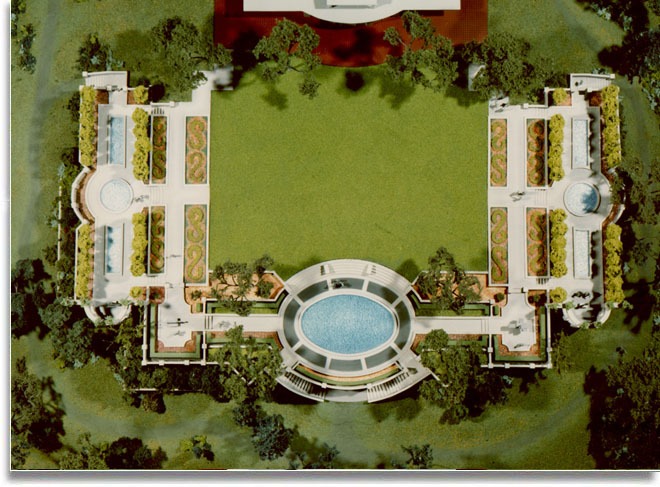 There is something endlessly fascinating about models of cities…Perhaps they enable us to relate to cities in ways that are normally not possible? Perhaps they give us a God’s eye view of the landscape and everyday life.
There is something endlessly fascinating about models of cities…Perhaps they enable us to relate to cities in ways that are normally not possible? Perhaps they give us a God’s eye view of the landscape and everyday life.
So if we could play God for a day what would we say to those people down there that we created and who are now running around living their own lives in the various metropolis’ of the world? Or perhaps we would just make our own historical narrative films!
Would we be tempted to move the pieces on the board? Re-arrange them slightly? Why would we want to do this? ….There is certainly something very appealing about the detailed scale models of street furniture produced for the city of Toronto! And of the very different in quality abstract garden model.
In 2006 Prof Michael J. Oswald and Professor Steffen Lehmann chatted about the use of models in architectural practice. Professor Lehmann said of his experience in the office of Arata Isozaki:
“When working in Tokyo, in Arata Isozaki’s studio in 1990, I learned to appreciate the luxury of getting ideas built in-house overnight. Isozaki always valued the resource of an in-house model workshop where exquisite pieces could be made quickly. Before leaving the studio in the evening, I would hand over the latest drawings to the model shop, and when I returned to the office in the morning, there would be an accurate polystyrol model on my desk, built overnight by hard-working, younger Japanese staff. Much effort and accuracy was put into these models, even if we only used them ephemerally, to instantly check a certain idea.”

I share the enthusiasm for models – and have exactly the same feeling about aerial photographs. They let one appreciate ‘wider truths’, which is presumably what a god would enjoy. Gilgamesh, who was two thirds god and one third human, had this feeling when looking down on Uruk from its walls. And maybe visitors to Legoland get this experience too!
I did not know about Arata Isozaki’s enthusiasm for models but I like his book on Japan-ness in Architecture and wonder if he uses models to explore this idea. And are the various Legolands examples of context-sensitive design?
As for what I would ask the people, if I could be God for a day, it would be ‘do you agree that I should have made a lot more islands?’
Are there any illustrations of this wonderful city with wonderful gardens designed by Gilgamesh?
I have added a plan of Uruk to the entry.
It seems according to the legend of Uruk that sacred groves had guardians – and that even in ancient times there was a desire to crop down the forests for profit.[ http://www.alwanza.com/art/humbaba3.html ]
I have an idea that the sacred grove known to Gilgamesh was in the Lebanon rather than in Iraq.
Or is Uruk located in Mesopotamia (parts of modern day Kuwait, Iraq, Iran, Israel, Lebanon, Jordan, and Syria.)? [ http://atwar.blogs.nytimes.com/2009/03/25/if-its-ctuesday-it-must-be-ctesiphon/ ] The archeological site of Uruk seems to be located in Iraq.
This reference ‘History of Egypt Chaldea, Syria, Babylonia and Assyria’ by G Maspero locates Urukh next to the Euphrates in in Egyptian Chaldea.[ http://www.gutenberg.org/files/17323/17323-h/v3a.htm ] Perhaps the location of Uruk and the scared grove depends on the date in history you are referring to?
Yes, Uruk in is Iraq but I have an idea the Sacred Grove was in what is now Lebanon – because there were no cedar trees in Iraq http://www.gardenvisit.com/history_theory/library_online_ebooks/ml_gothein_history_garden_art_design/western_asian_gardens
Christine comments:
This source suggests the cedar trees in the legend were located in Iran, and that Gilgamesh and Enkidu travelled to Iran in order to cut them down. See: Tablet 2. [ http://i-cias.com/e.o/gilgamesh.htm ]
The non-expert is driven to a quantitative approach – and I think more commentators locate the cedar trees in Lebanon than Iran. In fact I have not read of any cedar trees (as distinct from the cypress which is sometimes called a cedar) in Iran.
I am definitely in the non-expert category. Things shifted so much in the ancient world (and continue to do so in the discipline of archaeology/archaeo-biology) that I like to keep an open mind until conclusive evidence is available.
The cedar is certainly important in Lebanese material culture ie. the flag.
[ http://en.wikipedia.org/wiki/Cedrus_libani ]